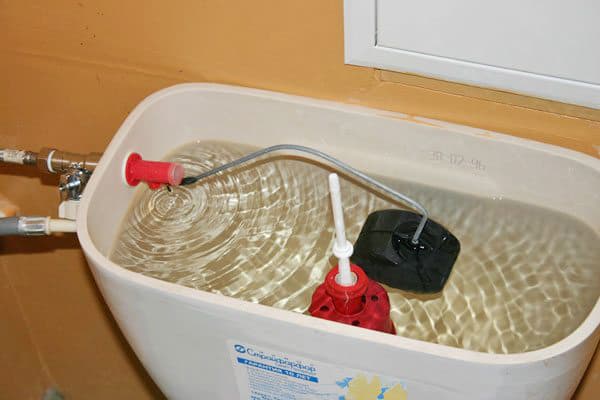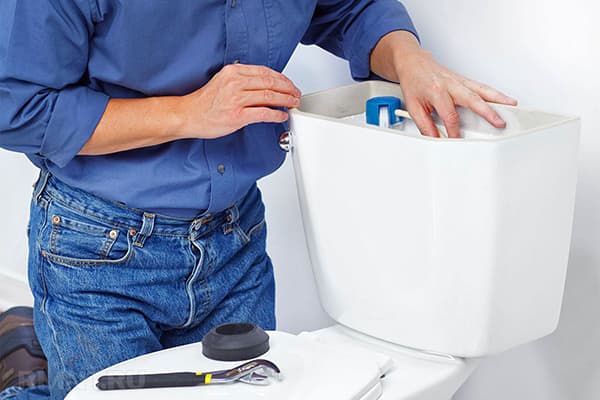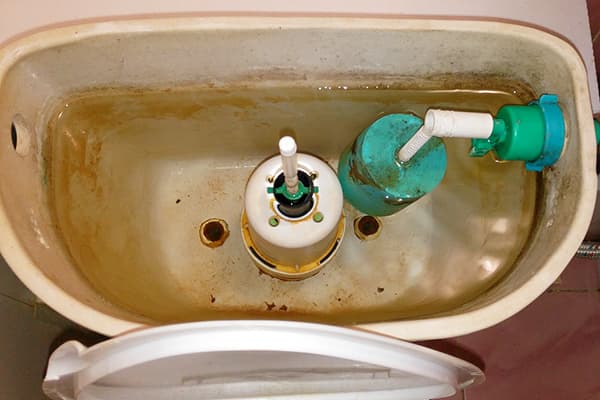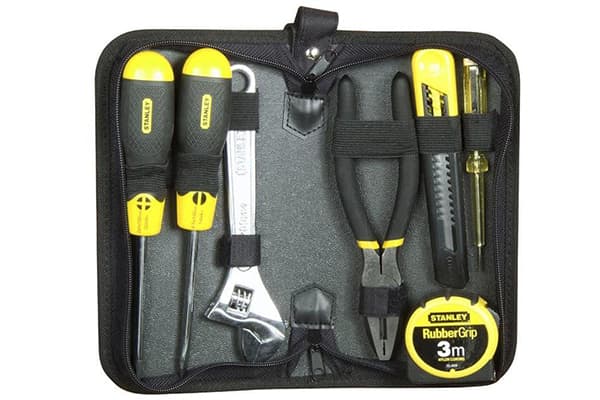Water constantly flows in the toilet - we repair the tank ourselves
Among plumbing malfunctions, the condition when water constantly flows in the toilet is one of the most insidious. This breakdown is easy to miss, and the wasted liters will gradually accumulate until the amount on the monthly pay slip exceeds all reasonable limits. To avoid financial losses and further problems with plumbing, you need to take immediate action.

How can you tell if there is a leak?
During normal operation of the toilet, after pressing the flush valve button, the contents of the tank are drained into the toilet bowl, carrying waste into the sewer. After the tank is empty, the float of the valve that regulates the water supply drops. Cold tap water begins to fill the tank. After filling, the float floats up again and the valve shuts off the liquid supply.
If the drain fittings or the plumbing fixture itself are faulty, water begins to flow into the bowl non-stop, and not just after pressing the drain button. In this case, water constantly flows into the storage tank (and is immediately poured out of it again). In fact, a leak in the toilet is the same hole in a family’s budget as a leaky faucet. Therefore, the sooner the problem can be detected, the better.
To notice a leak, you need to know the signs of its appearance:
- The sound of water flowing from the tank is constantly heard.
- The surface along which water flows remains constantly wet.
- Rust streaks quickly appear where the water jet exits.
- The meter impeller continues to move when the taps are closed and the plumbing fixtures are not working.
You should be wary if drops of water condensate appear on the hose through which water enters the tank. These droplets appear on cold surfaces. The water supply hose will be constantly cold if water flows continuously. If fed periodically, it will have time to warm up to room temperature.
If you find at least one sign of leakage, check the others as soon as possible. If you see at least 2-3 signs from the list, turn off the water supply to the toilet storage tank and take measures to correct the problem.
Ways to solve the problem
By stopping the water supply to the tank, you can gain time for repairs. But you need to act quickly: living without water in the toilet is very inconvenient. Of course, you can invite a plumber from a management company or a private company. But many types of repairs are easy to do yourself.
By acting ineptly, you can significantly damage the toilet or drain fittings. After this, you will need to invest much more money in repairs or replace the toilet completely.
Before repairing, look at the diagram of the drain fittings from your toilet. These instructions are included with the toilet upon purchase. The diagram can also be found on the Internet.
Why is the tank leaking?
So, the decision was made to handle the repairs on our own. The first step is to find the cause of the leak.
There can be several reasons for a leak:
- Damage to the valve that cuts off the water supply. In this case, the liquid will rise above the neck of the overflow pipe and go into the bowl.
- Dirty water. If the liquid entering the drain system contains solid particles (rust, sand particles, etc.), they can get under the rubber of the drain valve.
- Wear or deformation of the rubber seal. Because of this, the outlet from the storage tank is not completely blocked, and the water finds its way into the bowl.
- Damage to drain fittings. The appearance of cracks or holes in plastic parts is a common cause of leaks.
- Crack in sanitary ceramics. The most unpleasant option, which may require replacing the entire toilet.
Once the problem is identified, it should be fixed.
What is needed for repair?
For repairs, you will need the simplest tools that are found in every home: screwdrivers, a work knife, a hammer, a piece of sandpaper, pliers or a set of wrenches. You will also need sealing material - tow with grease and plumbing sealant.
It is also worth preparing a piece of rags to wipe your hands while working. If the water supply valve for the toilet is located in another room, it is better to work with an assistant.
How to fix a leak with your own hands?
First of all, you need to carefully remove the tank cap. Start by checking the valve that shuts off the liquid supply. Raise the float until the water stops flowing. If the leak is eliminated, you need to adjust the position of the float on the rod.
If this does not help, you need to remove the drain fittings and inspect the condition of the sealing rubber. Often it is enough to clean it of dirt to restore normal operation of the mechanism.
If this does not help, you will have to disassemble the tank in search of failed parts. These could be sealing gaskets between the tank and the shelf, bolts, tightening parts or parts of the drain fittings.
- The float may leak water due to a clogged rubber band. To clean it, you need to disassemble the float lever mounting assembly.After disassembly, the gaskets are washed and the rubber on the lever is replaced (it often develops wear). Video instructions will help you understand how this work is done:
- Another problem area is the rubber locking mechanism. Over time, it warps and the valve begins to jam. The problem is that with the low cost of the gasket itself, this part may not be available in the store. Buying entire fittings (for 800–900 rubles) for the sake of a 15-ruble elastic band is unprofitable. It is worth choosing a more or less suitable elastic band from the domestic range, cutting it and putting it in place. We offer video instructions for this operation:
- If you decide to change the entire fittings, you will have to turn off the water supply and empty the tank. Then unscrew the water supply hose with a wrench (a little liquid may spill out - replace the container). Then unscrew the fasteners and remove the tank. This will allow you to get close to the plastic nuts holding the reinforcement. We unscrew them, remove the shut-off valve and the float assembly, and install new parts. All stages of work are shown in the video:
Such repairs are already quite complicated for a novice plumber; it is better to seek help from an experienced specialist. But if this is not possible, you can figure it out yourself. The main thing is to do everything slowly, periodically checking the instructions for the fittings. Good luck with your work!



What if the tank makes a trilling sound at the end of the water flow?
There is another reason for the leak. This is a build-up of limescale at the base of the shut-off arm. A hard lump forms and prevents it from working properly. I had this story, the master came and quickly found the reason. I cleaned the structure and everything worked.
I don’t know how it works on Czech-made valves, I haven’t encountered them, but on ours, if it leaks from under the valve rubber, it is often enough to disconnect the rod with the gasket from the valve and lower it, with the rubber band, into a bowl with boiling water, and when the rubber softens, give it its original shape. To save water, when assembling the fittings, put a weight on the rod with an elastic band (for example, I have a 3/4 brass nut), then when you press the drain button, the water will not completely empty the tank, and when you release your finger, the rod instantly returns to the starting position!
The very idea of a cistern is vicious... it was good with low water pressure... but now the pressure is such that I can wash off the poop with a shower... But there is no use for tankless toilets for domestic purposes.
All industrial crap. But no toilets
In Moscow, any metal in a tank rots within a couple of years... the bolts even rot. Only plastic and this goodness is not enough. And the elastic bands are too hard and do not provide a tight fit…. and even after the same two years, lime settles on the rubber bands... I’m telling you, the tank itself as a device is flawed
Yes, silicone will be softer, but twice as expensive.
..in order for the meter to react to a water leak, the tank must be very thin; you will immediately see and hear such water consumption. And if you don’t notice this, then you’ll quickly go down the drain, in a day the abyss of water will flow away, you’ll pay for at least a month...
23 years of experience...if the leak is not related to the water level in the barrel - when it overflows, then nothing helps except replacing the fittings...someone is trying to clean the bottom rubber from lime and other deposits..but as a rule it helps very rarely...even the fittings are removed and put it in place, turning it won't hold it
fittings cost 350 rubles...imported and 900 rubles
there is another reason for the leak.....secret...if anyone knows, write
pour toilet fluid into the tank, wait 15 minutes, clean the tank with a brush, drain the water and that’s it, the water doesn’t flow. My husband advised me to do it for an hour, so I did it, there were no problems.